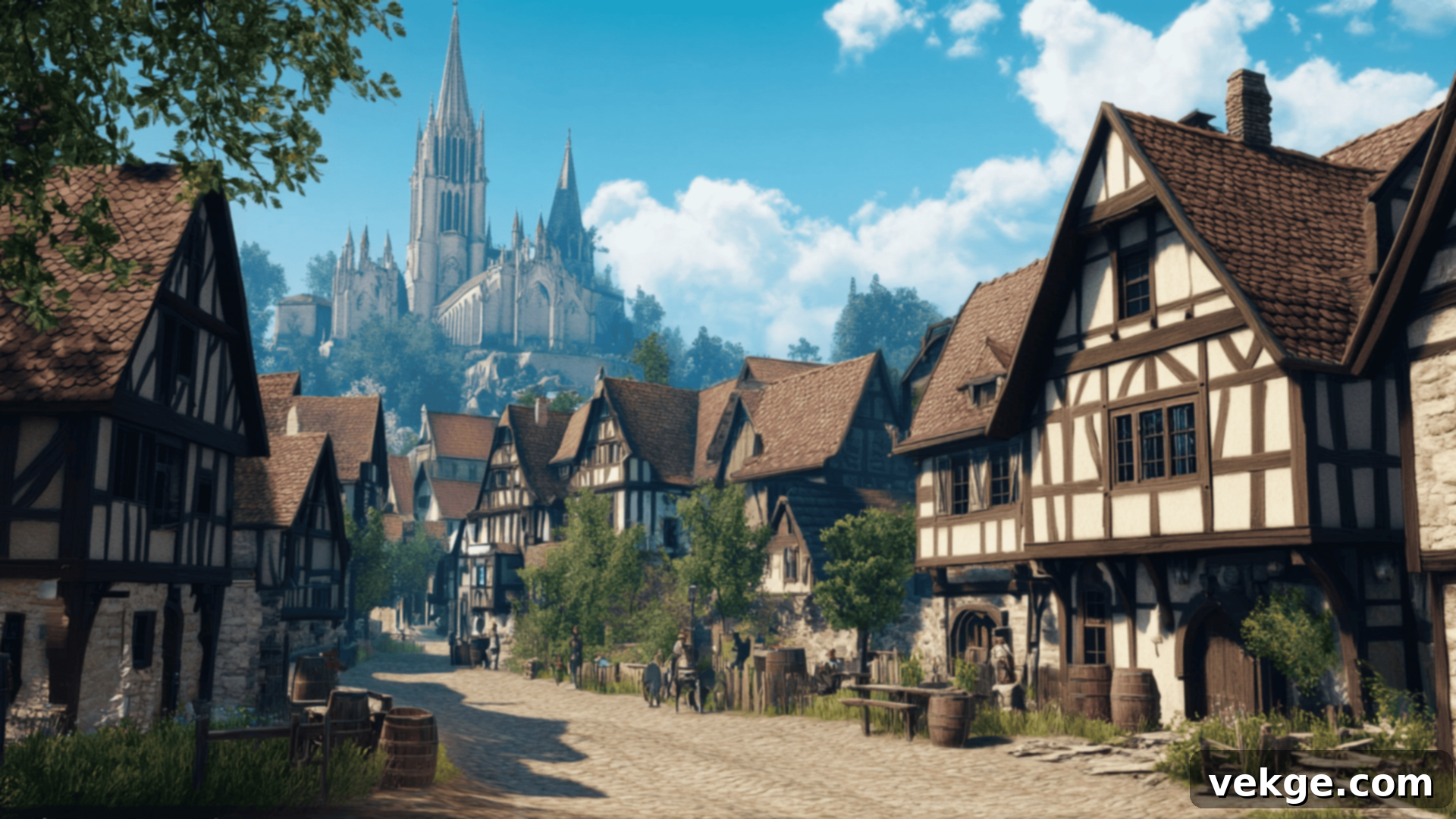Exploring Germany’s Rich Architectural History: Styles, Icons & Evolution
Have you ever wondered what gives Germany’s buildings their distinctive character and timeless appeal? The country’s architecture is far more than just structures; it’s a vibrant, living history, echoing stories that span thousands of years. From the imposing grandeur of Romanesque churches to the intricate charm of half-timbered homes, Germany’s built environment offers a fascinating journey through diverse eras and cultural influences.
As you delve into this guide, you’ll uncover how the robust Romanesque style laid the foundation for Germany’s earliest monumental buildings. We’ll explore how soaring Gothic cathedrals redefined religious architecture, reaching for the heavens, and discover why the opulent Baroque period infused palaces with such breathtaking detail. We’ll also highlight the iconic Fachwerk houses that continue to define the picturesque landscapes of Germany’s most charming villages. Join us as we take a closer look at these remarkable designs, offering inspiration for your own space or future travel plans.
Old German Architecture Through the Ages: A Historical Tapestry
Germany’s architectural landscape has been continuously shaped and reshaped over centuries, with each historical period leaving an indelible mark. From the enduring strength of Roman influences to the magnificent heights of Gothic cathedrals, and the later flourishes of Baroque opulence to the functional elegance of modern styles, every era narrates a distinct chapter in the nation’s rich history and cultural evolution. Let’s embark on a chronological exploration of the key architectural styles that have collectively forged Germany’s unparalleled heritage.
1. Ancient Roman Architecture: Foundations of Grandeur
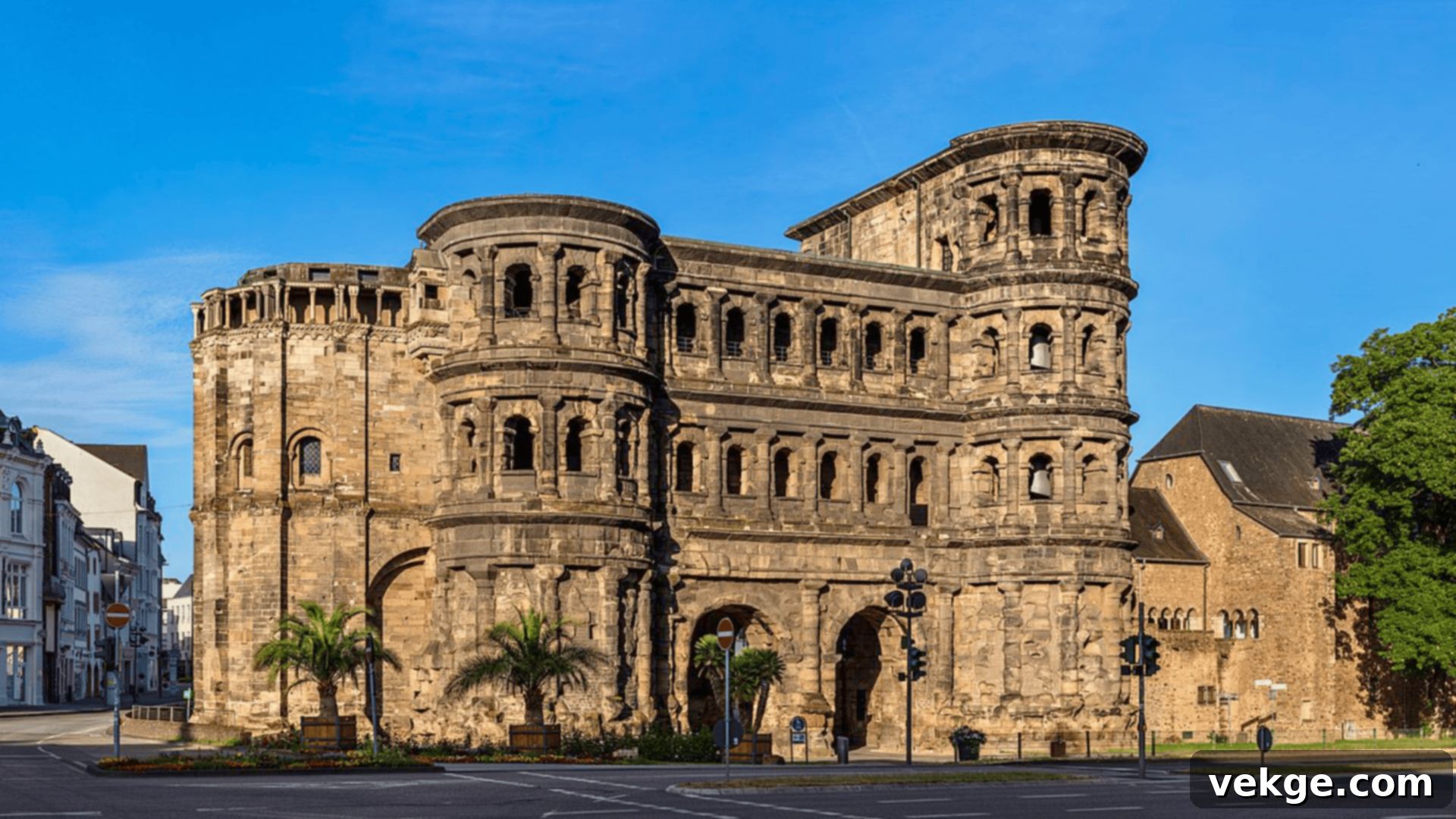
The Roman Empire exerted a profound and lasting impact on the earliest German buildings, particularly in the western regions. Among the most impressive testaments to Roman engineering prowess is Trier’s Porta Nigra, one of the best-preserved Roman city gates north of the Alps. This massive structure, built without mortar, showcases the Romans’ advanced building techniques and their mastery of stone construction, which allowed for unparalleled durability.
Beyond monumental gates, Roman infrastructure — including elaborate baths, extensive road networks, and fortified camps — significantly influenced the trajectory of future German architecture. The Romans introduced sophisticated construction methods like the use of strong arches and efficient aqueducts, which not only made their buildings more robust but also vastly improved their functionality and longevity. These pioneering techniques and design principles became foundational elements, setting the stage for subsequent architectural styles and elevating the standards of building across the region.
2. Romanesque Architecture: Strength and Spirituality

Emerging during the early Middle Ages, Romanesque architecture is distinctively characterized by its formidable thick stone walls, robust rounded arches, sturdy piers, and relatively small windows. This architectural style was predominantly employed in the construction of churches, monasteries, and castles, reflecting a period of consolidation and strong religious belief. Romanesque buildings were conceived with an emphasis on defensive strength and enduring presence, symbolizing stability in a turbulent era.
Two monumental examples that perfectly embody this style are Speyer Cathedral and Trier Cathedral. These structures, immense in scale, are defined by their imposing stone walls that convey a sense of unshakeable solidity and power. Inside, their designs are often grand yet surprisingly simple, featuring vast open spaces and minimal ornamentation that were intended to inspire awe and reverence in worshippers. The sheer mass and durability of Romanesque construction left a lasting legacy, forming the bedrock for future architectural innovations.
3. Gothic Architecture: Reaching for the Heavens

Beginning in the 12th century, Gothic architecture revolutionized ecclesiastical building, dramatically transforming the construction of churches and cathedrals across Europe, including Germany. This innovative style introduced key elements such as pointed arches, slender ribbed vaults, and the ingenious system of flying buttresses, which allowed for the construction of immensely tall walls and the incorporation of vast, light-filled stained-glass windows. The fundamental aim of Gothic design was to create buildings that soared towards the sky, symbolizing a direct connection to the divine.
Germany boasts some of the most spectacular examples of Gothic design, with Cologne Cathedral and Ulm Minster standing out as preeminent icons. Cologne Cathedral, a UNESCO World Heritage site, is celebrated for its breathtakingly tall spires and incredibly intricate decorative elements, which took over six centuries to complete. Ulm Minster, on the other hand, proudly features the tallest church spire in the world, a testament to the Gothic obsession with verticality and the profound impact of light within sacred spaces. Both of these magnificent structures were meticulously designed to evoke feelings of wonder, spiritual elevation, and profound reverence in all who beheld them, forever altering the landscape of German religious architecture.
4. Renaissance Architecture: A Return to Classical Harmony
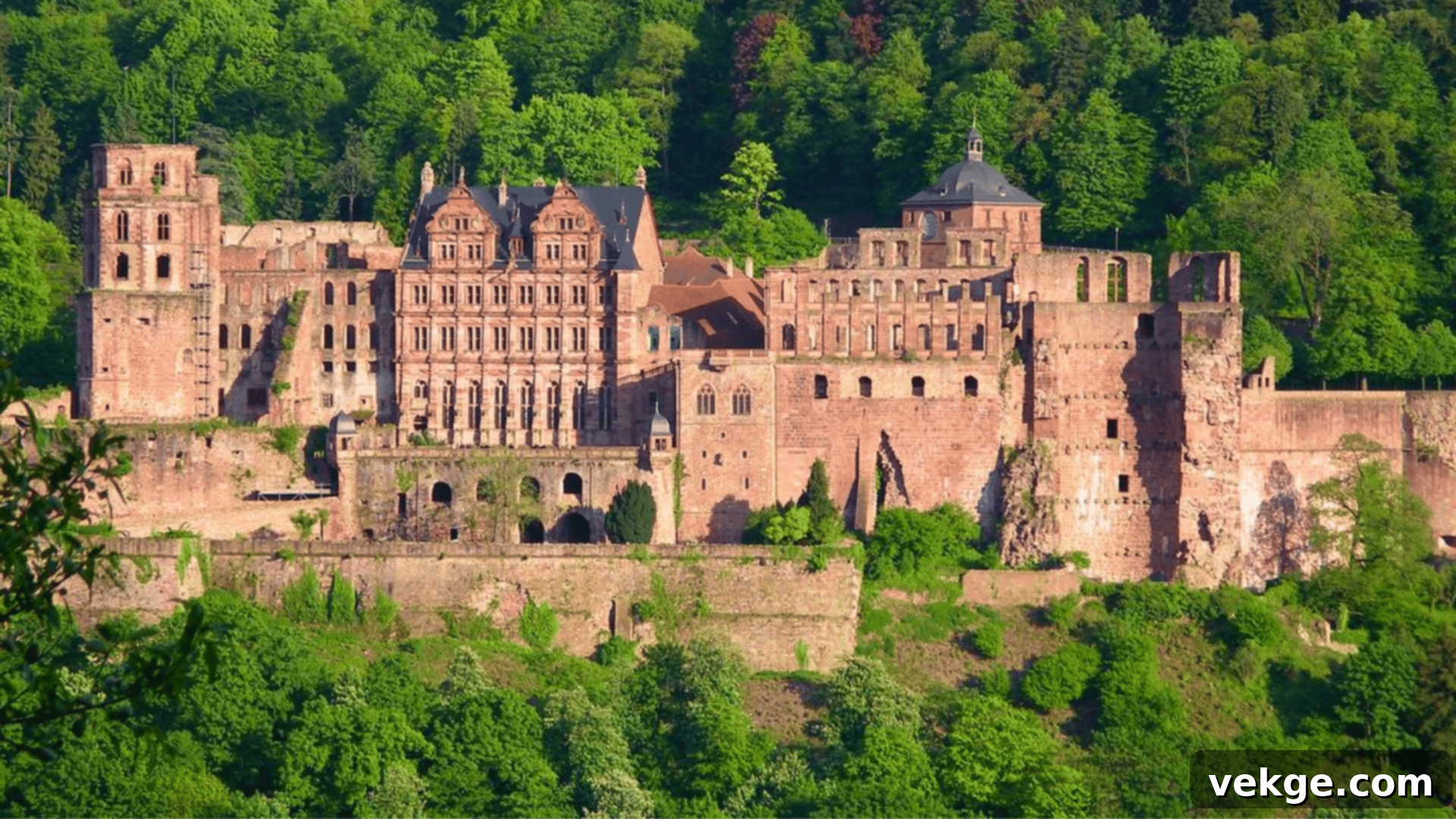
The Renaissance period, beginning around the 15th century, marked a significant departure from Gothic extravagance, initiating a fervent return to classical architectural styles. Drawing profound inspiration from the balanced, harmonious designs of ancient Greek and Roman buildings, Renaissance architecture placed a strong emphasis on principles of symmetry, precise proportion, and overall balance. This revival of classical ideals sought to create structures that were rational, ordered, and aesthetically pleasing.
This sophisticated style found its expression in the construction of grand palaces, stately churches, and important public buildings throughout Germany. Notable examples include the impressive Heidelberg Castle, which showcases a blend of defensive and residential Renaissance elements, and the magnificent Würzburg Residence, a sprawling palace that exemplifies the era’s dedication to refined beauty and functional grandeur. These buildings were meticulously designed to exude both beauty and perfect equilibrium, characterized by clear lines, logical layouts, and a sense of visual harmony. The thoughtful incorporation of classical elements like elegant columns, pilasters, and majestic domes bestowed upon these structures an undeniable sense of strength, grace, and intellectual sophistication, reflecting the humanism and renewed interest in classical learning of the age.
5. Baroque Architecture: Drama, Opulence, and Emotion
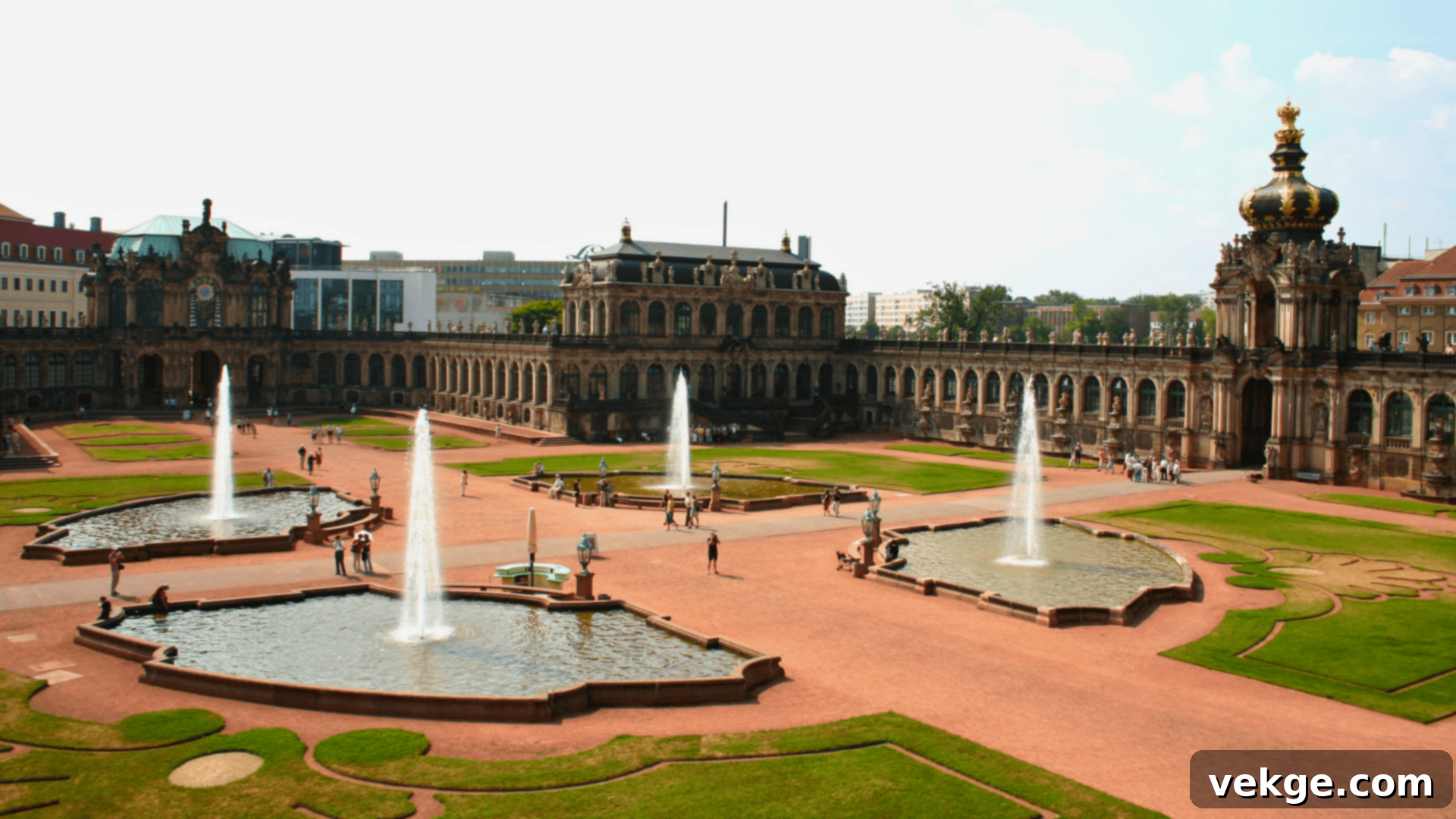
Baroque architecture, flourishing from the early 17th century, is renowned for its theatricality, lavish ornamentation, monumental scale, and dramatic use of light and shadow. This style was intentionally crafted to impress, to evoke strong emotions, and to overtly display power and grandeur, often through an abundance of elaborate decorations, dynamic forms, and rich materials. Unlike the rational calm of the Renaissance, Baroque sought to create a sense of movement, awe, and spectacle.
Germany is home to some of the most spectacular Baroque masterpieces. The opulent Zwinger Palace in Dresden, with its intricate sculptures, fountains, and exuberant design, is a prime example of the style’s decorative brilliance. Similarly, the rebuilt Dresden Frauenkirche, though later, embodies the Baroque spirit of grandeur and architectural ingenuity. These grand buildings are not just filled with intricate designs but actively engage the viewer with their swirling lines, vibrant frescoes, and a sense of boundless energy.
The Baroque emphasis on drama and emotional impact made these buildings feel alive, bustling with movement and dynamic energy. The characteristic use of sweeping curves, elaborate sculptural details, and rich, contrasting textures collectively created a profound sense of awe and breathtaking beauty, making every Baroque structure a truly immersive experience.
6. Rococo and Neoclassical Architecture: Elegance and Order

Following the Baroque era, Rococo architecture emerged in the mid-18th century, distinguished by its even more delicate detailing, playful asymmetry, and elegant, often whimsical designs. This style was frequently employed in the interiors of palaces and churches, where the primary objective was to cultivate a light, airy, and intimate atmosphere, adorned with an abundance of refined, shell-like decorations and pastel colors.
Iconic examples of German Rococo include Charlottenburg Palace in Berlin and Sanssouci Palace in Potsdam, the cherished retreat of Frederick the Great. These palaces are celebrated for their soft curves, exquisite frescoes, and intricate gilded stucco work, creating an impression of graceful lightness and sophisticated charm.
In contrast, Neoclassical architecture, which gained prominence towards the end of the 18th century, represented a return to the more austere and rational aesthetics of ancient Greece and Rome. It moved away from Rococo’s playful extravagance, favoring simpler, cleaner lines, monumental scale, and a renewed focus on classical forms such as columns, pediments, and geometric precision. Both Rococo’s refined elegance and Neoclassicism’s imposing order have profoundly influenced the design of Germany’s most important palaces and public buildings, each reflecting distinct cultural and philosophical shifts.
19th and 20th Century German Architecture: Innovation and Identity
1. Bauhaus Architecture: Form Follows Function
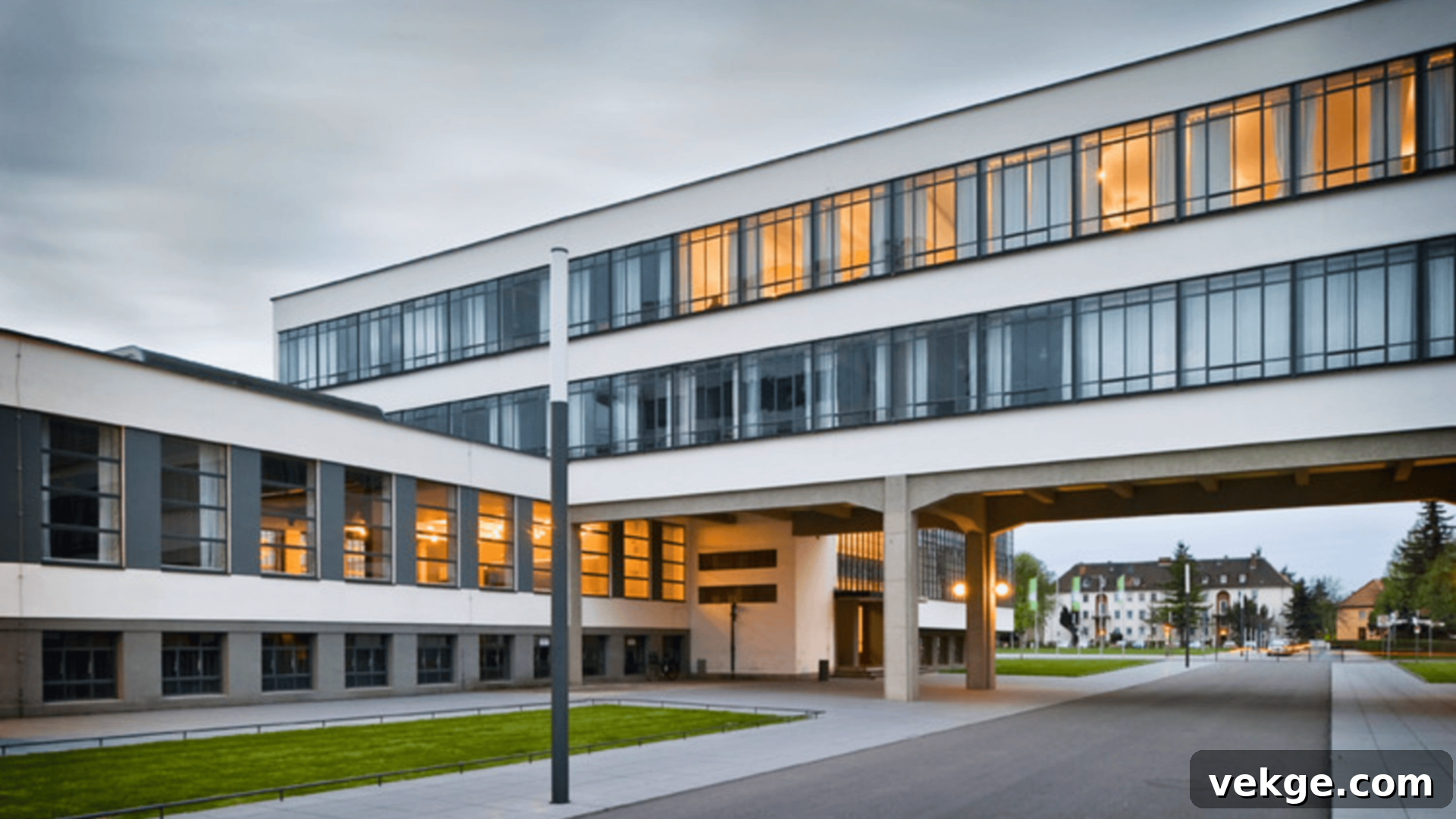
Bauhaus architecture, which originated in Germany in the early 20th century, revolutionized modern design with its emphasis on functionality, clean lines, and radical simplicity. The core philosophy of Bauhaus was to unify art, craft, and technology, creating buildings that were practical, efficient, and accessible, stripped of all unnecessary ornamentation. This movement aimed to redefine the relationship between form and function, believing that the form of a building should be dictated by its purpose.
The iconic Dessau Bauhaus School building, designed by Walter Gropius, stands as a quintessential example of this style, with its stark geometric forms, expansive glass curtain walls, and industrial materials. Similarly, numerous Bauhaus-style homes across Berlin showcase the movement’s commitment to light, air, and open living spaces. These structures are recognized for their innovative use of materials like reinforced concrete, steel, and large panes of glass, combined with simple, unadorned shapes. Bauhaus design was groundbreaking for its time, fundamentally altering how buildings were conceived and constructed. Its enduring focus on utility, modularity, and minimalist aesthetics continues to influence contemporary architecture worldwide.
2. Jugendstil (Art Nouveau): Organic Curves and Nature’s Embrace
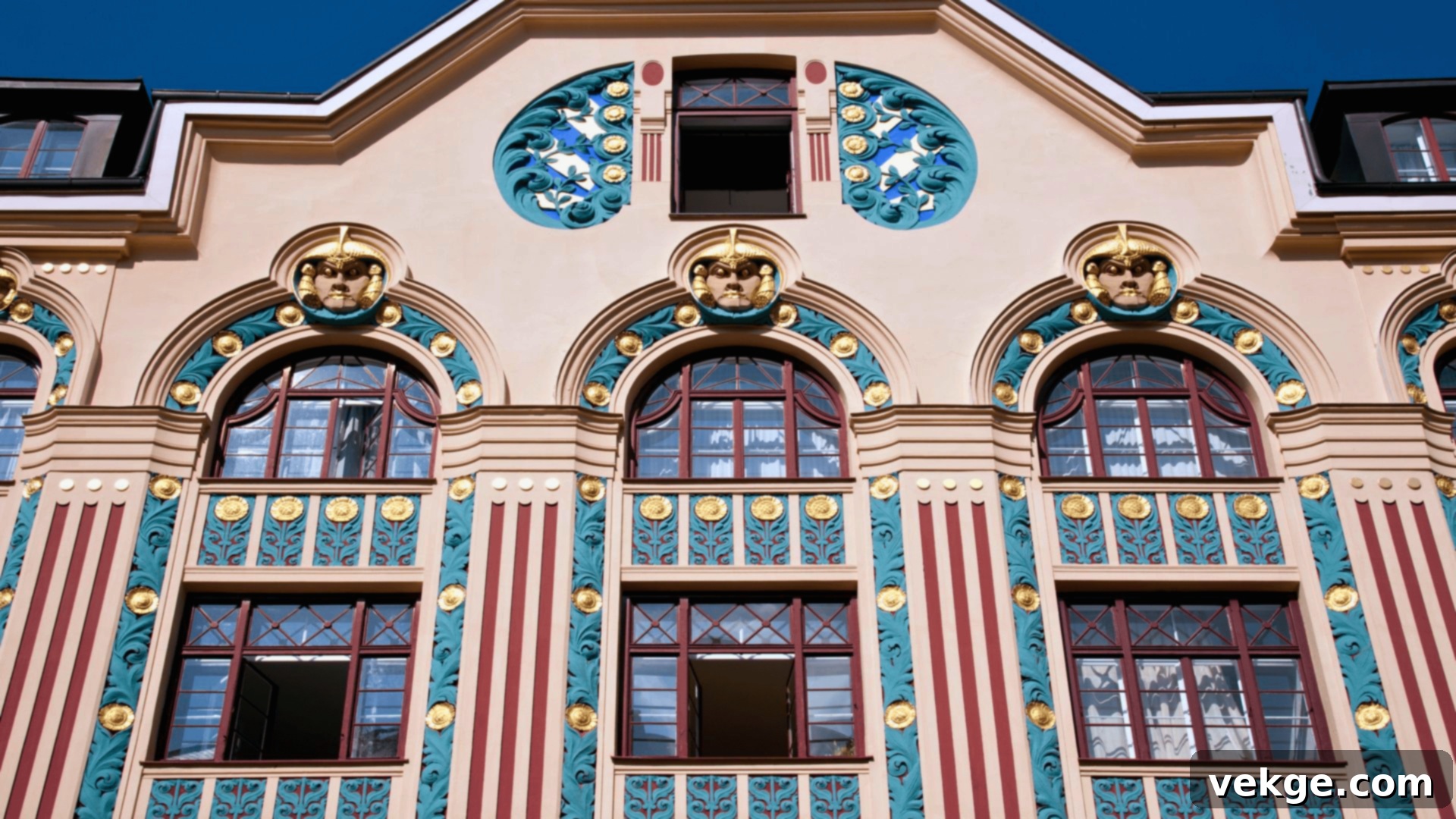
Jugendstil, the German variant of Art Nouveau, emerged around the turn of the 20th century, renowned for its flowing, curved lines, nature-inspired motifs, and organic, often asymmetrical shapes. This artistic and architectural movement sought to break away from historical revivalism, aiming instead to create a “total work of art” where buildings were seamlessly integrated with their interior furnishings and decorative elements, often drawing inspiration from the natural world.
Famous examples of Jugendstil architecture can be found in cities like Augsburg, with its distinctive Art Nouveau houses featuring whimsical facades, and Munich, home to many elegant Jugendstil buildings adorned with intricate details like stylized flower patterns, undulating curves, and allegorical figures. These structures are celebrated for their craftsmanship, vibrant use of color, and the way they combine artistic expression with architectural form. Jugendstil introduced a new era of elegance and aesthetic beauty to buildings, blurring the lines between art and architecture and infusing urban environments with a fresh, organic vitality.
3. Expressionist Architecture: Bold Forms and Emotional Impact
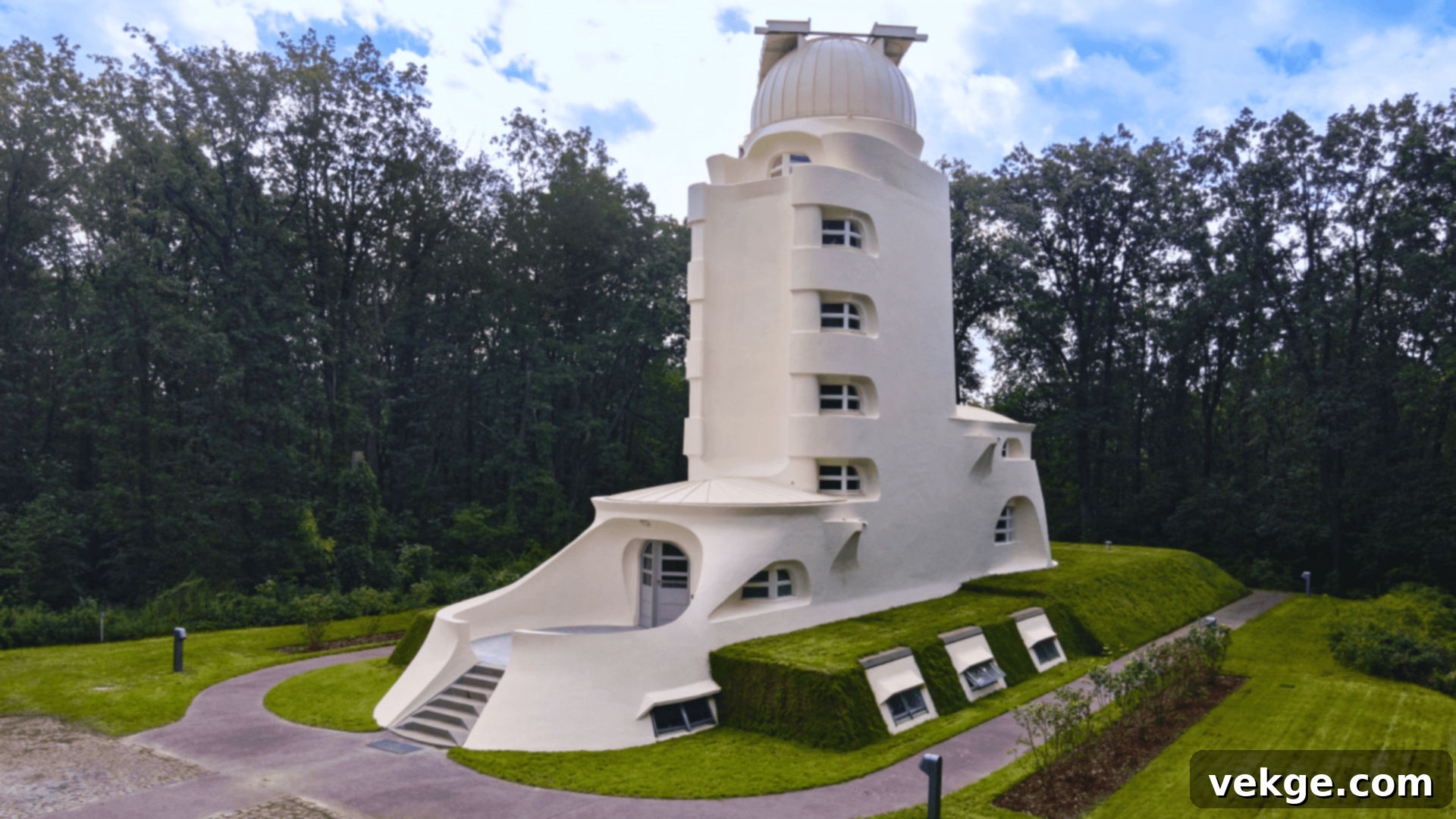
Expressionist architecture, flourishing primarily in the early 20th century, is characterized by its bold, dramatic designs and an emphasis on individual artistic expression over rational functionality. Architects of this movement sought to convey emotion, often through the use of unique, sculptural shapes, unconventional materials, and a deliberate rejection of traditional architectural norms. These buildings were intended to be visually striking, creating a powerful emotional or symbolic impact.
Key examples of Expressionist architecture in Germany include The Einstein Tower in Potsdam, designed by Erich Mendelsohn, an iconic observatory that resembles a solidified sculpture, and Cologne’s Theater am Dom, known for its dynamic facades and unconventional massing. These buildings feature unusual, often organic, shapes, dramatic curves, and a sense of movement that makes them incredibly eye-catching and thought-provoking. Expressionist architecture is fundamentally about pushing creative boundaries and making a strong, unforgettable impression, embodying a spirit of avant-garde innovation.
4. Historicism and Revivalism: Echoes of the Past
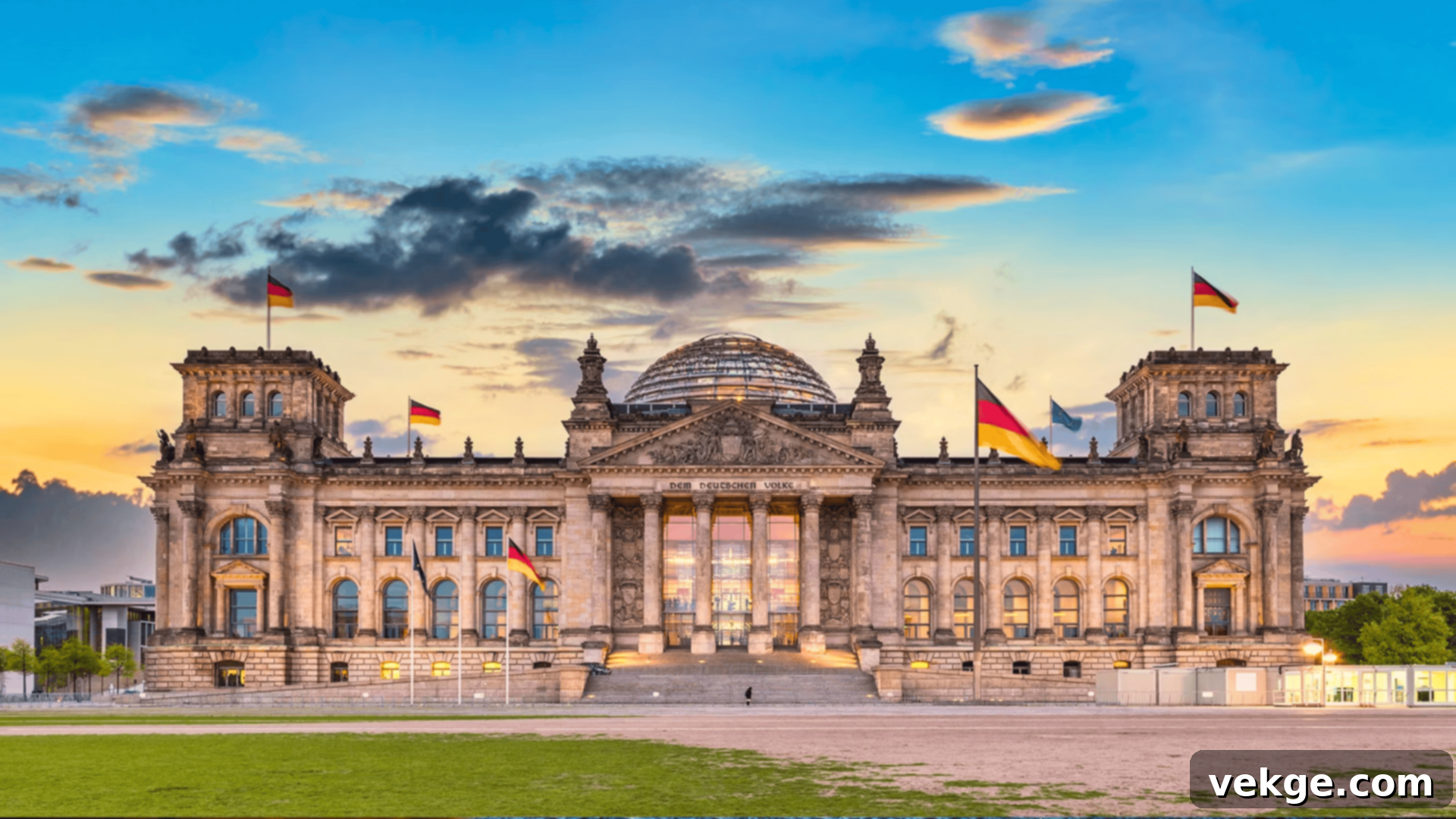
Historicism and Revivalism represent architectural movements of the 19th and early 20th centuries that consciously drew inspiration from, and often directly copied, earlier building styles. This period saw architects reinterpreting and combining elements from Romanesque, Gothic, Renaissance, and Baroque eras. This approach became popular as a means of reconnecting with a rich historical past, particularly during times of national identity formation or urban renewal, often symbolizing continuity and tradition.
Notable buildings from this period in Germany include the majestic Reichstag Building in Berlin, originally designed in a Neobaroque style, which later saw the addition of a modern glass dome, beautifully blending old and new. Another significant example is the Kaiser Wilhelm Memorial Church, which, in its ruined state alongside a new church, serves as a powerful reminder of history and resilience. These structures ingeniously blended the grandeur and aesthetic principles of historical styles with the advanced construction methods and materials of their time. Historicism and Revivalism played a crucial role in creating buildings that respected the architectural legacy of the past while simultaneously embracing modern ideas, contributing to the diverse and layered urban fabric of German cities.
Iconic Half-Timbered Homes in Old German Architecture: The Charm of Fachwerk
Fachwerk homes, or half-timbered houses, are arguably one of the most recognizable and beloved elements of traditional German architecture. These distinctive homes are characterized by their exposed timber frames, which form the primary structural skeleton of the building. The spaces between these robust wooden beams are then filled with various infill materials such as brick, plaster, wattle and daub, or stone. This construction method is not only practical but also creates a unique, highly aesthetic facade.
The beauty of Fachwerk lies in the visible timber frame, which is not merely decorative but integral to the building’s integrity. The infill materials add insulation and additional strength, while the prominent display of the beams gives these homes an instantly recognizable, charming, and often picturesque appearance. This timeless look continues to be admired and celebrated today, drawing visitors to Germany’s historic towns and villages.
Regional Styles and Examples of Fachwerk
The design of half-timbered houses varies considerably across different regions of Germany, each area developing its own unique patterns, ornamentation, and construction nuances. Quedlinburg, a UNESCO World Heritage site, is particularly famous for its remarkably well-preserved collection of timber-framed homes, with some buildings dating back as far as the 14th century. Its medieval streets are a living museum of Fachwerk, showcasing the evolution of the style.
Rothenburg ob der Tauber, another jewel on the Romantic Road, also boasts a wealth of beautiful half-timbered houses. The town itself has a magical, fairy-tale quality, largely thanks to its colorful, meticulously maintained timber-framed homes that line its winding cobblestone streets and contribute to its iconic silhouette. These homes, with their exposed beams and traditional craftsmanship, not only capture the enduring charm and rich history of Germany’s architectural heritage but also offer a tangible connection to centuries of communal life and skilled artistry.
Regional Variations in Old German Architecture: A Kaleidoscope of Styles
1. Bavarian Style Architecture: Alpine Charm and Frescoed Walls
Bavarian-style architecture is immediately recognizable for its distinctive chalet-like buildings, robust construction, and characteristic alpine roofs. These homes are often ingeniously designed to thrive in mountainous environments, featuring steeply sloped roofs that are highly effective at shedding heavy snowfall, a crucial adaptation for the region’s climate. The design often incorporates broad eaves and ornate wooden balconies, adding to their rustic charm.
A hallmark of Bavarian architecture is the frequent use of vibrant frescoes on exterior walls, showcasing intricate scenes from nature, traditional folk art, or religious themes. These colorful murals not only beautify the buildings but also tell stories and express local identity. Additionally, distinctive onion domes are a common and beloved feature on many Bavarian churches, adding a unique, often whimsical, touch to the regional architectural landscape and making these structures instantly identifiable.
2. Saxon and Franconian Towns: Unique Timber Patterns and Vibrant Hues
In the historic towns of Saxony and Franconia, visitors will discover a captivating array of homes distinguished by their unique timber patterns and diverse structural layouts, each contributing to the special character of its village. These towns are often designed with narrow, winding streets and picturesque squares, enhancing their medieval charm and inviting leisurely exploration. The architectural styles here often reflect local traditions and available resources, resulting in a rich tapestry of designs.
A striking feature of homes in these regions is their vibrant exterior paintwork. Buildings are typically adorned in a palette of lively colors, making them stand out against the backdrop of the landscape and creating a cheerful, welcoming atmosphere throughout the town. These colorful exteriors, often complemented by intricate half-timbering, collectively impart a lively and inviting feel to each town, reflecting a deep-seated pride in regional heritage and aesthetic expression.
3. Frankfurt’s Old Town and Modern Restoration: Blending Past and Present
Frankfurt am Main, a city of contrasts, offers a compelling narrative of architectural resilience and innovation. After suffering extensive destruction during World War II, a significant portion of Frankfurt’s Old Town was painstakingly rebuilt. However, this wasn’t merely a reconstruction of the past; it was a deliberate and thoughtful restoration effort. Many of the historic facades were carefully preserved or meticulously recreated, while concurrently, modern design elements were seamlessly integrated.
This approach has resulted in a fascinating blend of historical charm and contemporary aesthetics. The restored buildings beautifully retain their traditional character and historical resonance, while the incorporation of new designs introduces a fresh, dynamic look. This unique juxtaposition of old and modern architectural styles makes Frankfurt’s Old Town an exceptionally distinctive and engaging place to visit, symbolizing the city’s ability to honor its past while confidently embracing the future.
Notable Old German Buildings and Landmarks: Architectural Masterpieces
1. Cologne Cathedral: A Gothic Masterpiece
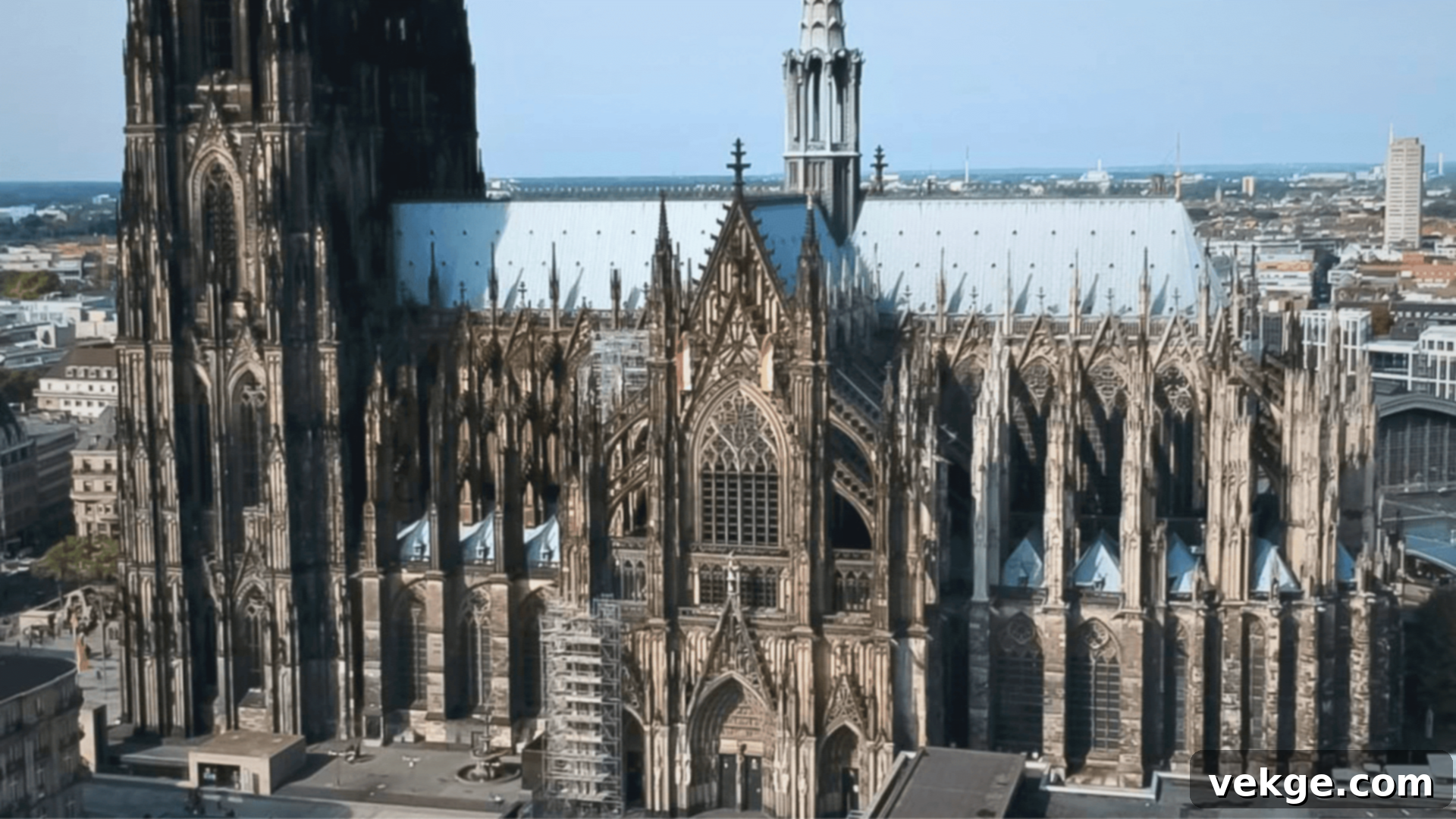
Cologne Cathedral is not only one of the largest Gothic cathedrals in Europe but also a breathtaking testament to medieval ambition and architectural genius. Renowned for its towering twin spires that dominate the city skyline and its incredibly intricate stained-glass windows, the cathedral is a UNESCO World Heritage site. Construction began in 1248 and remarkably took over 600 years to complete, making it an iconic and enduring symbol of Germany’s profound architectural and religious history. Its sheer scale and detailed craftsmanship continue to inspire awe.
- Type: Cathedral
- Style: Gothic
2. Trier’s Porta Nigra: Roman Engineering Marvel

The Porta Nigra, meaning “Black Gate,” is a monumental Roman city gate located in Trier, Germany’s oldest city. Built in the 2nd century AD, it stands as one of the best-preserved Roman gates in Europe. This impressive structure, constructed from large blocks of sandstone without mortar, is a powerful showcase of advanced Roman engineering and military architecture. It serves as a striking reminder of Trier’s historical significance as a Roman capital.
- Type: City gate
- Style: Roman
3. Heidelberg Castle: Renaissance-Gothic Fusion

Perched majestically on a hill overlooking the enchanting city of Heidelberg, Heidelberg Castle is a dramatic ruin that beautifully blends Renaissance and Gothic architectural styles. This historic landmark has been the site of countless historical events and battles, contributing to its romantic and evocative atmosphere. While partly in ruins, its magnificent facades and courtyards offer stunning views of the Neckar valley and the surrounding area, embodying centuries of German history and artistic evolution.
- Type: Castle
- Style: Renaissance-Gothic
4. Neuschwanstein Castle: A Fairy-Tale Dream
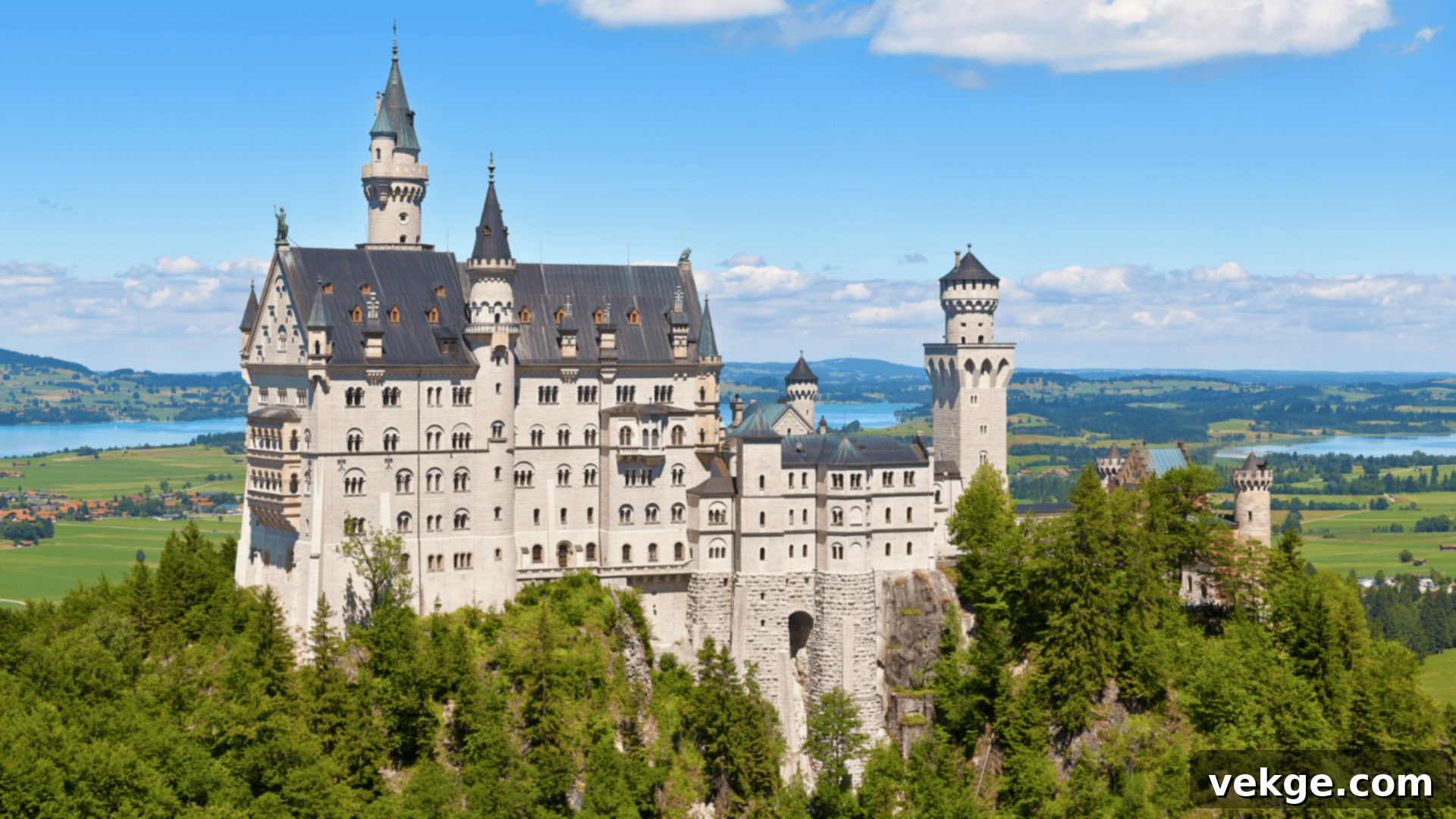
Neuschwanstein Castle, nestled in the Bavarian Alps, is a world-famous, fairy-tale-like castle built in the 19th century by the eccentric King Ludwig II. Inspired by medieval designs and Wagnerian operas, it is a prime example of the Romantic revival style, albeit executed with cutting-edge 19th-century technology. Though never fully completed, its picturesque beauty and stunning alpine setting make it one of Germany’s most visited and photographed landmarks, inspiring countless stories and even Disney castles.
- Type: Castle
- Style: Romantic Revival
5. Speyer Cathedral: Romanesque Grandeur
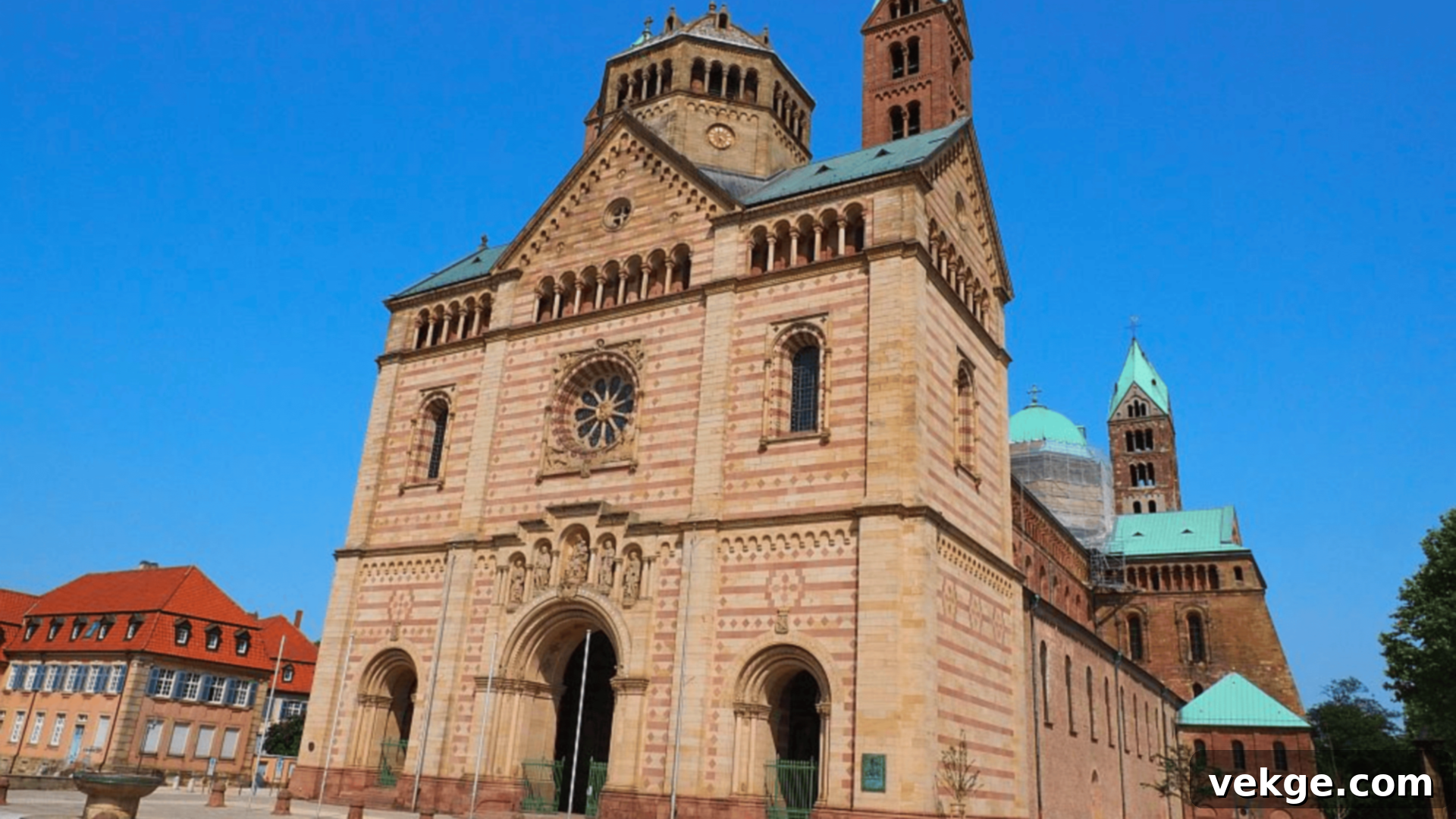
Speyer Cathedral is one of Germany’s most significant Romanesque churches, recognized for its massive scale and its esteemed status as a UNESCO World Heritage site. Constructed largely in the 11th century, it is one of the largest Romanesque cathedrals in the world. The cathedral’s architecture features extraordinarily thick walls, imposing towers, and a simple yet grand design that powerfully conveys the strength and spiritual conviction of the High Middle Ages. It also served as the burial site for many Holy Roman Emperors.
- Type: Cathedral
- Style: Romanesque
6. Würzburg Residence: Baroque Opulence
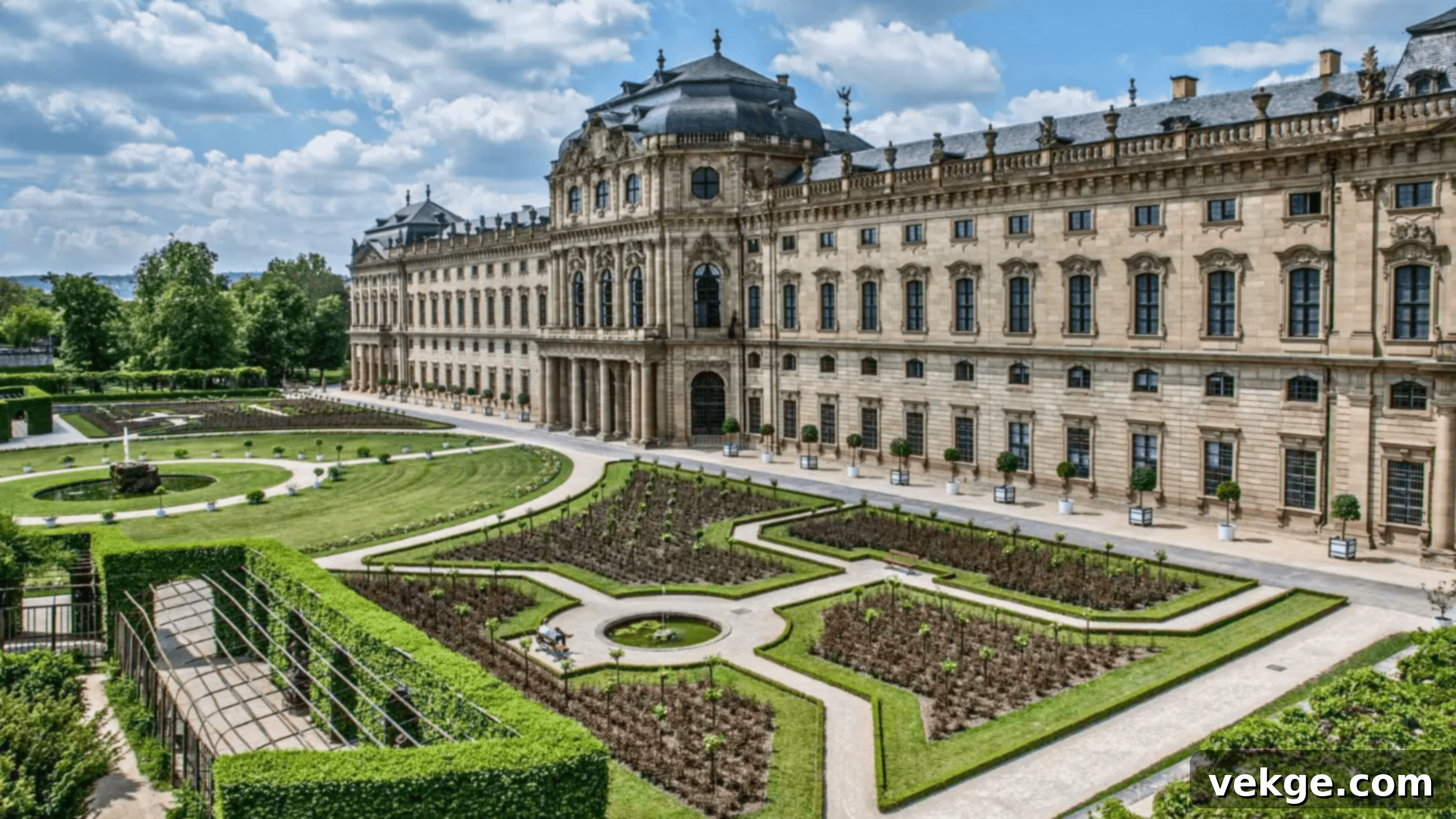
The Würzburg Residence is a magnificent Baroque palace situated in Würzburg, Bavaria, renowned for its lavish interior designs, breathtaking frescoes by Tiepolo, and meticulously landscaped gardens. Constructed in the 18th century as the residence of the Prince-Bishops of Würzburg, it stands as one of the most beautiful and complete Baroque palaces in Germany. This UNESCO World Heritage site is a testament to the wealth and artistic aspirations of its era, captivating visitors with its unparalleled grandeur and artistic detail.
- Type: Palace
- Style: Baroque
7. Sanssouci Palace: Rococo Elegance
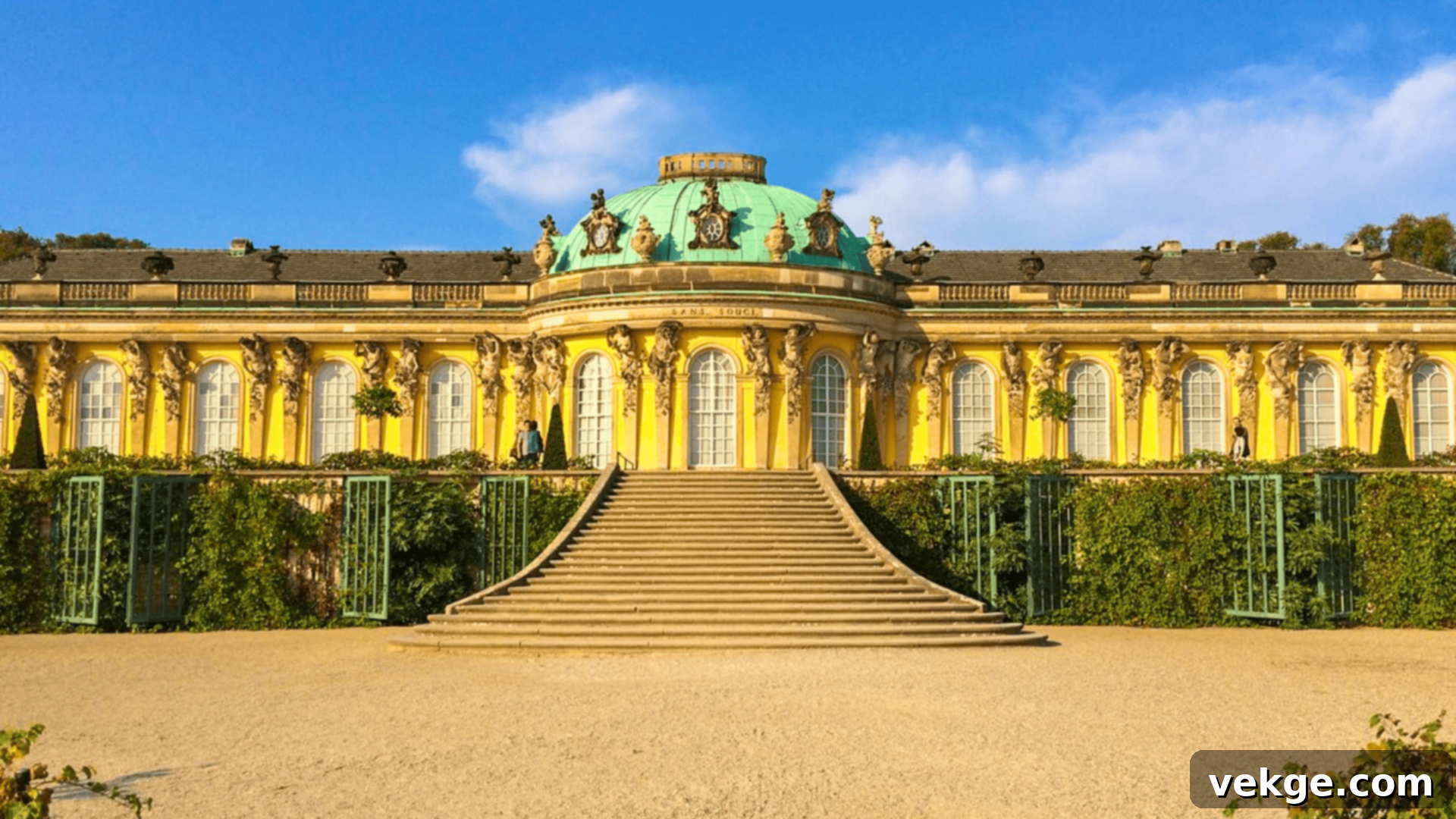
Sanssouci Palace, located in Potsdam, Brandenburg, is a exquisite Rococo palace built for Frederick the Great, King of Prussia, in the mid-18th century. Known for its intimate scale, light and airy design, and stunning terraced gardens, it served as Frederick’s summer retreat and private residence, a place “without worries.” The palace features beautifully adorned interiors, delicate rocaille decorations, and an overall sense of refined elegance, reflecting the personal taste of an enlightened monarch.
- Type: Palace
- Style: Rococo
Common Materials and Design Features in Historic German Architecture
Throughout its history, old German architecture predominantly relied on a selection of robust and readily available materials: timber, stone, brick, and clay tiles. Each material played a crucial role in shaping the aesthetic and structural integrity of buildings across different regions and eras. Timber was a primary choice, most notably for Fachwerk (half-timbered) houses, where its strength and flexibility allowed for distinctive structural expressions. Stone and brick, revered for their exceptional durability and fire resistance, were favored materials for monumental constructions such as churches, cathedrals, and castles, ensuring their longevity through centuries.
Clay tiles, with their excellent weather-resistant properties and availability, were almost universally used for roofing, particularly prevalent in regions characterized by wetter climates. The strategic selection and masterful application of these materials were fundamental not only to the structural strength and long-term endurance of German buildings but also contributed significantly to their unique beauty and regional character. The craftsmanship involved in working with these natural elements is a testament to the skill of generations of German builders.
The architectural design of roofs in old German buildings was often a direct response to the local climate conditions. In regions prone to heavy snowfall, such as Bavaria and the alpine foothills, roofs were typically constructed with steep slopes. This practical design allowed snow to slide off easily, preventing excessive accumulation that could damage the structure. Conversely, in areas with milder weather, flatter roof designs were more common, reflecting less urgent demands for snow shedding and sometimes allowing for more decorative elements.
Thus, the style and shape of the roof were not merely aesthetic choices but critically functional elements, designed to help buildings withstand the elements while simultaneously contributing to their overall visual appeal and regional identity. Each region’s climate profoundly influenced how structures were conceived and designed, ensuring resilience and harmony with the natural environment.
Conclusion
Germany’s architectural heritage offers an incredibly rich and diverse journey through history, reflecting the nation’s evolving cultural, political, and artistic landscapes. From the ancient Roman strongholds to the awe-inspiring heights of Gothic cathedrals, the grandeur of Baroque palaces, and the enduring charm of half-timbered towns, each style tells a unique story of ingenuity, resilience, and beauty. This architectural tapestry is a profound testament to the human spirit’s capacity for creation and adaptation across millennia.
If these magnificent buildings and the stories they hold have piqued your interest, we strongly encourage you to experience them firsthand. A personal visit allows you to truly grasp their scale, absorb their intricate details, and feel the weight of history within their walls. Alternatively, delve deeper into their fascinating narratives by exploring the wealth of information available online or in specialized books. Engaging with these places, whether physically or through study, will undoubtedly enrich your understanding of Germany’s profound culture and complex history.
Don’t wait! Start planning your visit to these incredible sites or dedicate some time today to research more about the captivating beauty of Germany’s diverse architectural marvels. Embark on your own journey of discovery and witness the architectural wonders that have shaped this remarkable country.
